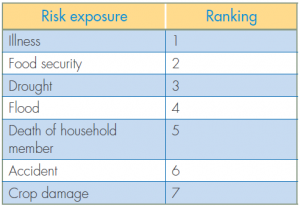Microinsurance Study
Increased access to diverse financial services can enable the poor and the vulnerable to devote more resources to their crops, develop protective measures against shocks, and gain access to markets, ultimately graduating from poverty. However despite the growing body of research on microinsurance globally, there is a relative lack of research on the microinsurance industry in Cambodia.

Risk Ranking
This report looks at essential elements of market suitability assessment for microinsurance, such as: Risk perception, product attribute preference, affordability and willingness and client awareness. In so doing the research identifies possible entry points for further research but especially confirms Cambodian supply and demand interest in the sector. This analysis could then be used to inform the formulation of technical recommendations on potential microinsurance product designs, education campaigns, and marketing strategies.
The primary research drew on both quantitative and qualitative methods, including in-depth interviews (IDIs) comprising of mostly closed questions to enable quantitative analysis; focus group discussions (FGDs); village chief interviews (VCIs); and interviews with experts (microinsurance operators and other relevant organizations). IDIs were conducted across three provinces and five villages within each province, encompassing a variety of microinsurance coverage and poverty levels. One FGD was arranged in each village and each FGD consisted of six to eight participants. FGDs used a participatory approach and comprised of the following activities: risk ranking, product-attribute ranking and promotion-activity ranking. The results are also informed by secondary data analysis and review, including an examination of the current microinsurance products on offer, the applicable legal and regulatory framework, and other relevant research reports.
The EMC report is available online here. An article covering UNDP engagement with private sector on microinsurance is here.
Comments are closed.